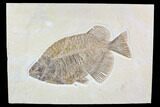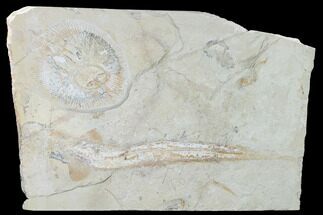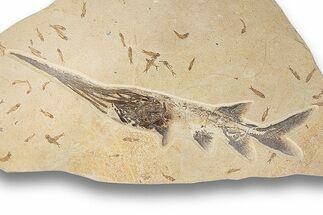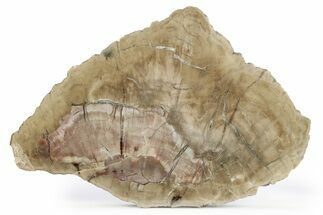This Specimen has been sold.
Exceptional 13.5" Fossil Fish (Phareodus) - Wyoming
This is a superb 13.5" long example of one of the more uncommon fossil fish found in the Green River Formation, Phareodus. It is remarkably detailed and nicely presented on an 18 x 10.6" slab of shale. Just check out the closeup photos to see the detail in this magnificent specimen.
There are several repaired cracks running through the rock and the fish with some restoration along the crack repairs. There is also some restoration to the raised back bone of the back half of the fish. The shale it was on was thin so the rock has been backed with hardie board for stability and to make it easy to mount on a wall. We can install a french cleat wall hanger for no charge.
If you look closely you can see how Phareodus has a mouthful of sharp pointy teeth making it a voracious lake predator. In fact the name Phareodus actually means "to have tooth". Spines from other fish such as Mioplosus and Priscacara have frequently been found preserved in it's stomach.
There are several repaired cracks running through the rock and the fish with some restoration along the crack repairs. There is also some restoration to the raised back bone of the back half of the fish. The shale it was on was thin so the rock has been backed with hardie board for stability and to make it easy to mount on a wall. We can install a french cleat wall hanger for no charge.
If you look closely you can see how Phareodus has a mouthful of sharp pointy teeth making it a voracious lake predator. In fact the name Phareodus actually means "to have tooth". Spines from other fish such as Mioplosus and Priscacara have frequently been found preserved in it's stomach.
About Fossil Lake
50 million years ago, in the Eocene epoch, these fish thrived in Fossil Lake, which was fed by the Uinta and Rocky Mountain highlands. The anoxic conditions at the bottom of Fossil Lake slowed bacterial decomposition, prevented scavengers from disturbing corpses, and, most interestingly, suffocated creatures that ventured into the oxygen-starved aquatic layer. The result is a miraculous exhibition of Eocene biota: a subtropical aquatic community within sycamore forests, teeming with creatures such as freshwater stingrays, dog-sized horses, menacing alligators, early flying bats, and one of the first primates.
50 million years ago, in the Eocene epoch, these fish thrived in Fossil Lake, which was fed by the Uinta and Rocky Mountain highlands. The anoxic conditions at the bottom of Fossil Lake slowed bacterial decomposition, prevented scavengers from disturbing corpses, and, most interestingly, suffocated creatures that ventured into the oxygen-starved aquatic layer. The result is a miraculous exhibition of Eocene biota: a subtropical aquatic community within sycamore forests, teeming with creatures such as freshwater stingrays, dog-sized horses, menacing alligators, early flying bats, and one of the first primates.
SPECIES
Phareodus testis
LOCATION
Fossil Safari Quarry, Kemmerer, Wyoming
FORMATION
Green River Formation
SIZE
13.5" long on 18.5x12.8" rock
CATEGORY
SUB CATEGORY
ITEM
#107467
We guarantee the authenticity of all of our
specimens. Read more about our
Authenticity Guarantee.
specimens. Read more about our
Authenticity Guarantee.
 Reviews
Reviews












